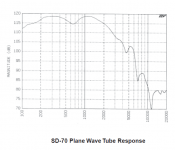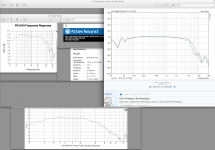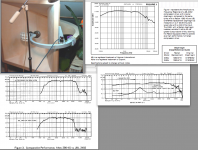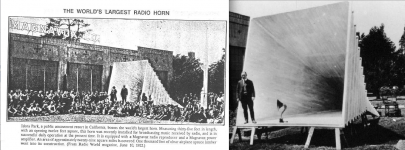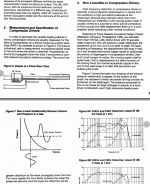"They", as in the 2nd, 3rd & 4th harmonics. H2, H3, H4. They can show you important things that may not be obvious in a simple FR chart.
We do you think I doubt Dietmar? What he's done is amazing, I'd just like to see more of the picture before jumping into it myself. Maybe other folks would, too. Simple.
We do you think I doubt Dietmar? What he's done is amazing, I'd just like to see more of the picture before jumping into it myself. Maybe other folks would, too. Simple.
As impressive as the modified K55/Atlas PD5V is, I am convinced that Atlas has
two even more impressive drivers. If the goal is to use a good
tractrix or Seos from about 800-1200hz on up, these drivers are killer. I think
they approach Goto level bass performance to below 100hz. Honestly.
The SD-70 and SD-370.
SD-70 = 112 db w/m at 100hz on PWT.
58W full power operation at 200hz.
If they are not lying to us(and they havent with he PD5V) this is it. Search over.
A 6db crossover at 700hz will exhibit a 1200hz crossover point with a pretty steep
slope. Just ideal to couple to a good mid horn:
two even more impressive drivers. If the goal is to use a good
tractrix or Seos from about 800-1200hz on up, these drivers are killer. I think
they approach Goto level bass performance to below 100hz. Honestly.
The SD-70 and SD-370.
SD-70 = 112 db w/m at 100hz on PWT.
58W full power operation at 200hz.
If they are not lying to us(and they havent with he PD5V) this is it. Search over.
A 6db crossover at 700hz will exhibit a 1200hz crossover point with a pretty steep
slope. Just ideal to couple to a good mid horn:
Attachments
Last edited:
As impressive as the modified K55/Atlas PD5V is, I am convinced that Atlas has
two even more impressive drivers. If the goal is to use a good
tractrix or Seos from about 800-1200hz on up, these drivers are killer. I think
they approach Goto level bass performance to below 100hz. Honestly.
The SD-70 and SD-370.
SD-70 = 112 db w/m at 100hz on PWT.
58W full power operation at 200hz.
If they are not lying to us(and they havent with he PD5V) this is it. Search over.
A 6db crossover at 700hz will exhibit a 1200hz crossover point with a pretty steep
slope. Just ideal to couple to a good mid horn:
I can not find the SD-370 on the Atlas site and it seems to be obsolete from suppliers?
Made for Federal Sound. Pssst.I can not find the SD-370 on the Atlas site and it seems to be obsolete from suppliers?
/itm/Federal-Signal-Atlas-Soundolier-FS100W-EOWS-Compression-Driver-POLICE-FIRE-Siren-/221227205922?pt=BI_Security_Fire_Protection&hash=item33822b4522]Federal Signal Atlas Soundolier FS100W Eows Compression Driver Police Fire Siren | eBay[/url]
I wonder if the Altas AS100N is similar? It's a siren driver with a Neo magnet.
Specs can be found here:
http://www.atlassound.com/FileDownload/AS100N_Data_Sheet_____ID1680.pdf
Doesn't play very high, in stock form.
Specs can be found here:
http://www.atlassound.com/FileDownload/AS100N_Data_Sheet_____ID1680.pdf
Doesn't play very high, in stock form.
Yes, sound quality remains to be a mystery until one decides to try it.SD-70 weighs 600 grams more than a K55-V, and it plays in average 5 dB louder, 116dB compared to 111dB. I wonder if they gave any thought to sound quality, when the purpose was police sirens.
At this price there is little to loose.
I don't know how these units are different than the K55? Magnet weight for sure anything else would be speculation.
Actually,how can a speaker with more than 20 grams moving
mass be any better that this 2-3 gramm phenolic diaphragm driver?
arger diaphragms can of course make more SPL with less excursion, but require larger magnet structures to control the added mass.I don't know how these units are different than the K55? Magnet weight for sure anything else would be speculation.
Actually,how can a speaker with more than 20 grams moving
mass be any better that this 2-3 gramm phenolic diaphragm driver?
The AS100N has a 2.75" diaphragm, so it has quite a bit more Sd than the PD-5VH.
The frequency response is much more narrow than the K55/PD-5VH, but it looks like it could cover the decade from 200-2000 Hz on a "mini Sato" with no modification.
Attachments
Could not find plane wave tube response for the 290, but I'd expect its LF to be less than the Altec 288 since it rolls off more than the JBL 2482.I have a pair of the very large and heavy Altec 290 drivers that are rated to play low and have phenolic 'frams. They also top out circa 5KHz. I've never been able to get much under 300Hz from them, but then maybe I don't have a big enough horn.(size does matter)
The horn has to be huge and long for these compression drivers to go low, and the huge horn will have less output potential in the 100-200 Hz range than a 12" speaker in a small box.
Efficient though, nice for those in love with low power amps.
Attachments
Last edited:
Yes Art, I looked again and the 290 is given down to just 300Hz. Maybe with some mods it will play lower. 
Having heard the big W.E. driver in the big W.E. horn as low mids, I have to say no direct radiator comes close. It's in a league by itself. Of course I'll get a lot of argument about that from people who haven't heard it, but I don't care.
Having heard the big W.E. driver in the big W.E. horn as low mids, I have to say no direct radiator comes close. It's in a league by itself. Of course I'll get a lot of argument about that from people who haven't heard it, but I don't care.
The big horns like the W.E. or the Sato have directivity down to a fairly low frequency, certainly no direct radiator comes close in that regard.Yes Art, I looked again and the 290 is given down to just 300Hz. Maybe with some mods it will play lower.
Having heard the big W.E. driver in the big W.E. horn as low mids, I have to say no direct radiator comes close.
Having heard a number of big horns (though not as big as the Sato) driven by compression drivers with diaphragms from 1.5" to 4", my impression is that directivity and harmonic distortion both play key roles in their sonic signature.
The lower and louder the small diaphragm horns are driven, the more distortion they produce.Mucho distortion, or not much?
The problem is (at least) two fold, we expect distortion to increase with excursion, but in addition air becomes non-linear at the high SPL in a horn throat, as mentioned in the JBL Technical Notes Volume 1, Number 8, Characteristics of High-Frequency Compression Drivers :
"In a horn-driver combination, such high pressures develop even greater distortion as the wave propagates down the horn. The more rapidly the horn flares outward, the lower the pressures become, and the lower the distortion will be."
To achieve a low frequency cut-off with a tiny diaphragm, a very long, slowly flaring horn is required, which also increases distortion.
Distortion makes things sound louder, so a distorting horn/driver does increase the sense of dynamics
Art
Attachments
That all makes sense - except that the WE 555 on the WE 15a is by far the cleanest midrange I've ever heard. Nothing else comes close. I never measured one, but to my ear it was the cleanest thing I've ever heard in that range. Amazingly so. If that's distortion - give me more of it! 
I would imagine that the WE15A with it's continuous curve makes for a big part of the magic if it were straight it would not likely sound the same at all. much of the distortion mentioned may well get canceled out and lost. I can't say for sure. What do you think? Best regards Moray James.
- Home
- Loudspeakers
- Multi-Way
- New ideas for K-55 and PD-5V compression drivers
